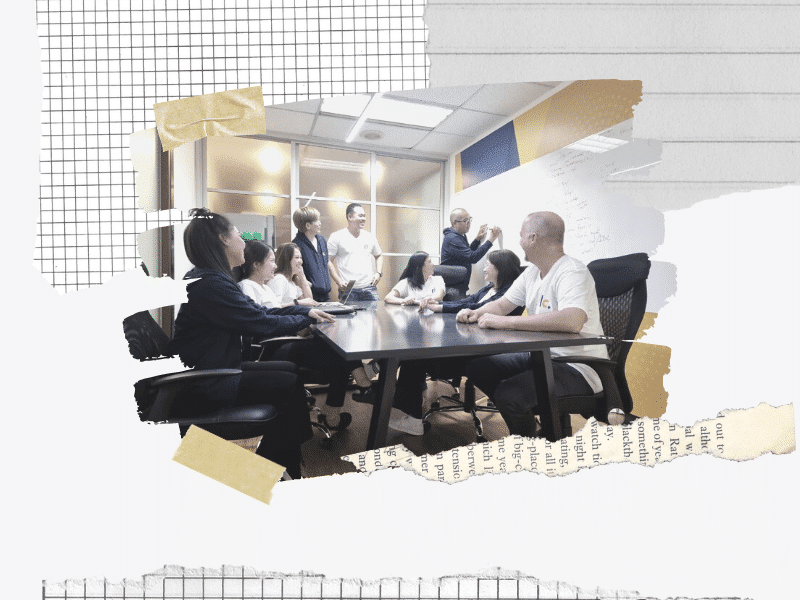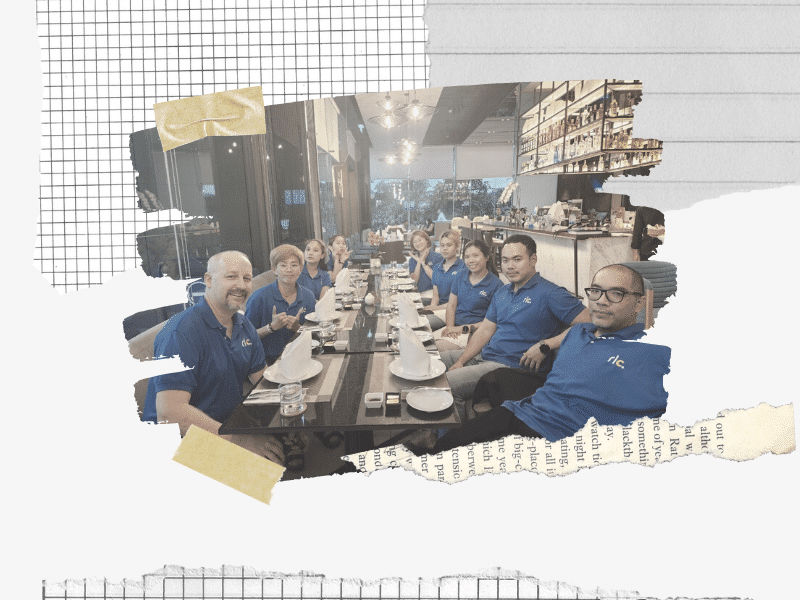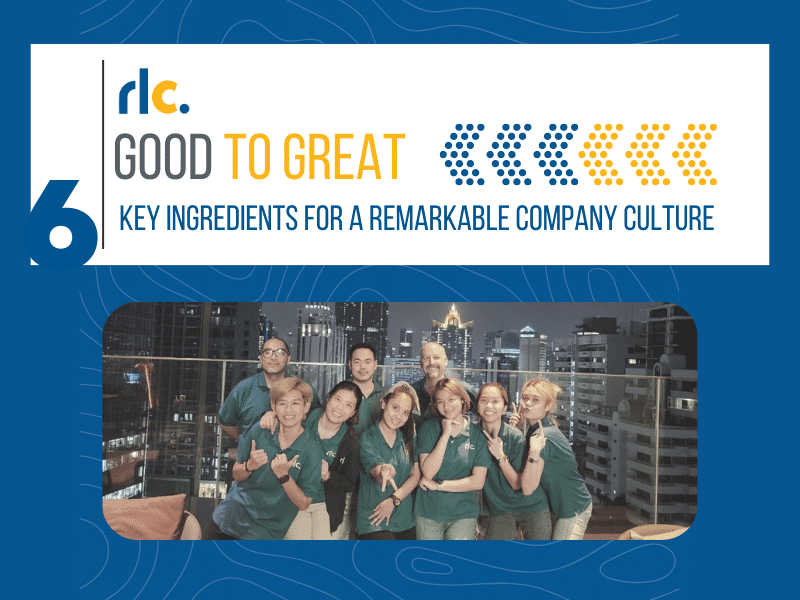I had been asked by my marketing team to write a blog on company culture and specifically how it relates to our company RLC’ culture. So below in this blog I seek to shed some light on some of the things which I believe must exist to create a great and sustained company culture that helps to underpin company performance. What I discovered as I set off on my journey of discovery and reflection follows.
Firstly I did the usual thing, procrastinated, procrastinated some more, did some research, listened to a number of podcasts from leaders of great companies, listened to audio books and then finally did some self-reflection and tried to make some observations about what we do well at RLC and what makes our company culture drive the company’s success. What I realized during the last several months was very insightful.
What is Company Culture?
Let’s look at what a typical definition says about company culture. Company culture refers to the shared values, beliefs, behaviours, and practices that shape the overall character and identity of an organization. It encompasses the unwritten rules and norms that guide how employees interact with each other, make decisions, and carry out their work. Company culture can be seen in various aspects of an organization, including its leadership style, communication patterns, work environment, employee engagement, and recognition programs.
A strong company culture can have a significant impact on an organization’s success. It influences how employees perceive their work environment, their level of job satisfaction, and their overall motivation and engagement.
A positive company culture can foster a sense of belonging, promote collaboration, and inspire innovation, leading to increased employee productivity and retention. On the other hand, a toxic or negative company culture can result in low employee morale, high turnover, and decreased performance.

Let me reflect on some of these aspects; in order for a company to share its values, beliefs, behaviours and practices, it needs to communicate well with its employees so that a common understanding is reached. This is often done through regular team meetings, monthly company recognition meetings, management meetings and regular communication throughout the organization through the normal channels. This in itself is common of most companies, so why is it that some companies seem to get this right while others get it so wrong?
Well let’s look team meetings for example, how are they conducted? Is a top-down approach of communication adopted? Or is there a free flowing and engaging conversation taking place? Are employees freely sharing opinions and openly communicating with each other and top management? Are different viewpoints expressed or are employees sharing what they perceive as expected responses from top management to fit with the norm of that company’s culture?
It is easy to say let’s have an open meeting where all employees share ideas and opinions, however the difficulty lies with the unspoken and unwritten rules and norms that lie at the heart of that particular company’s culture.
For example knowing that in Company A, the boss doesn’t like to hear any negative feedback or opposing view points, doesn’t appreciate new business ideas or feedback from employees in contradiction to his beliefs or ideas would suggest such viewpoints will not be expressed by employees at that company to ensure harmony is maintained. If a boss doesn’t like to be questioned then of course employees tend not to offer direct feedback on what they are really thinking even where this feedback could be very valuable. Typically companies will avoid having so called awkward moments to keep the harmony at least at the surface level.
On the other hand, a company that value’s its employees input will define and value open and transparent communication, reward it and ensure that employees understand that it is critical to share information, provide feedback especially critical feedback from clients.

At RLC we do try and practice this religiously. When underlying tension exists in the office it can quickly affect the mood in the office (this should be easy to spot if you have worked in Thailand long enough!) we address it head on by having a meeting behind closed doors with all parties involved which is designed to get to the heart of the issue and cut through the bullshit and politics (one of our rules is no office politics).
Quite common practice at these meetings is that on occasion employees start to cry. Getting to the core of the matter is the key point and can be a very cathartic experience for all involved. As a result, true breakthroughs where genuine feelings are discussed, addressed and the real issues are actioned to improve the underlying situation can take place. We have a running joke that if you haven’t cried at our office at least once you haven’t been here long enough!
RLC’s Culture: 6 Keys to Transform Good to Great
Let’s explore the 6 keys for RLC culture to take things from just good to great. We’ll dive into the important factors that make all the difference in creating an amazing organizational environment.
1.TRUST
Great company cultures are built on the back of trust being at the heart of the company. No company can have a great company culture if employees have misgivings about management or vice versa. Creating a company culture where trust is given and received starts with management setting out a clear vision, purpose, strategy and set of expectations and sharing this with employees on an ongoing basis.
Once this has been communicated to employees, regular updates are important but critically important is that the company remains focused and does not “chop and change direction” especially abruptly with very little notice as this can derail the trust that has been built up over time.
A lack of trust can also result in a high turnover as employees will simply decide to up and leave without any prior notice of their dissatisfaction. Needless to say trust and honesty go hand in hand. Knowing that employees have trust in the company allows the business to move forward unencumbered.

2.EMPOWERMENT AND LEADERSHIP STYLE
At the heart of a great company culture you will find happy and engaged employees. They feel that they are empowered to do their work, they feel appreciated for what they contribute to the company, they know what their job is and importantly they are self-motivated to achieve their career and personal goals.
The signs that a company is doing well in this regard is employees turn up for work on time and you don’t see an abundance of unexplained sick leave. The leader of the business is obviously a key component in setting the company culture.
I have found that what works well is to genuinely empower employees with their work. Many company leaders cannot help but try and micro manage their employees this is a sure way to create high turnover in the business. As a leader I always try and empower my employees, value and encourage their feedback, ask questions rather than offer potential solutions to problems as they are often in the best place to make the right call.
Leadership is difficult and far from proclaiming to have mastered the art, through many lessons learnt I have adapted a style that seems to work and fit with our company culture here at RLC.

3.THE RIGHT EMPLOYEES
It seems obvious that to create a great company culture, you need to have the right employees in the business. Getting this wrong can be toxic to the company’s culture and believe me I have learned this the hard way over the years having stumbled countless times.
Putting in place a rigorous approach to recruiting the best employees to fit your company culture is critical to the company’s success. Rather than simply focusing on past experience of the candidates, look beyond educational background and experience to uncover what their values are and importantly how these values match the company’s values.
Skills can be trained and experienced is gained on the job, but having the wrong mindset and outlook can be detrimental to their success and more importantly it will be a toxic recipe for your company’s culture. Having one employee that does not fit into the company can have a big impact on the organization’s performance and team morale.
Lastly if you do recognize that an employee is not right for your company, don’t delay taking the necessary countermeasures, the sooner the issue is addressed the better and importantly don’t be shy about openly communicating this amongst the team. The worst thing is that an employee suddenly disappears, and this is somehow brushed under the carpet. Finally in the words of Jim Collins, author of “Good to Great” ensure you have the right people on the bus!
4.TRANSPARENCY AND ORGANIZATION STRUCTURE
I can only share my experience of having run an SME in Thailand over many years, it pays to keep things simple. Running a business with a small team doesn’t require many layers of management to separate employees on the front lines with senior management.
Flat hierarchy structures in this regard are the best approach. As a leader make yourself approachable to all employees at the same time respect what reporting structures are in place and avoid jumping over a manager and going straight to an employee. This simple approach to running the business can have a big impact on the company’s culture.

5.PERFORMANCE ORIENTATION
Setting the goals of the company in terms of performance expectations is critical in creating a great company culture. Being clear about what is acceptable and what is not, ensuring employees strive for excellence in their daily work helps foster the momentum for company performance.
Having the right incentive systems in place that place emphasis on company performance, individual performance and personal goals as well as company values is a must in terms of creating the right synergy when it comes to company culture.
At RLC we have developed a customized Performance Management System (Internally we call this our “Performance Incentive System”) which values in equal parts the company’s performance, the individual’s performance and the employee’s long-term contribution to the business measured in terms of tenure at the company. There is no confusion on how performance is measured and regular communications and “refreshers” are set up to ensure everyone is on the same page.
The huge benefits are that when it comes to annual reviews there are no big surprises or uncomfortable conversations, in fact, the employee leads the discussion as to how they have contributed throughout the year and achieved their results.

6.WORK LIFE BALANCE
Having experienced working through the Covid pandemic all companies have had to manage what working from home or increasingly working from anywhere looks like for their individual organization.
It is interesting to see that some bigger companies are increasingly resorting back to demanding employees come back to the office while other companies have adapted and fully adjusted to the new working norms.
At RLC we embrace a full transparent and open work from home policy which works well for our company and adds to healthly work life balance. Additionally, we have recently adopted a finish work early on Friday approach in order to encourage employees to be productive while at work and then switch to a downtime mode over the weekend ready to recharge the batteries.
Work hard play hard is something we take to heart and practice through company dinners, outings and incentive trips. The key is to ensure there is continuity and widespread participation among employees.
Chronic absenteeism at such company events can point to a sign that something is wrong with your company’s culture when employees don’t want to engage with work outside of normal work hours.
Summary
In summary, company culture and how one sets about creating a great and sustained culture that will help to drive company performance is a complicated topic and there is no one recipe for success rather it’s a combination of many factors discussed.
Above all working together to create an environment that is comfortable, rewarding, fosters engagement and collaboration and meets the expectations of both employee and employer is important.
When companies get it right it can really help to push breakthrough performance, when companies get it wrong however it can really be detrimental to staff morale, engagement and ultimately company performance suffers as a result.
At RLC we pride ourselves on our company culture and put a very high emphasis on carefully examining many aspects including future company plans and what likely impact they will have on the existing company culture.
When you place a priority on creating the right company culture and always recognize the importance it plays in successfully running the business you set yourself up for future success.

Markus’s corporate HR experience allows him to quickly focus on the pain points of business leaders and HR leaders alike.

